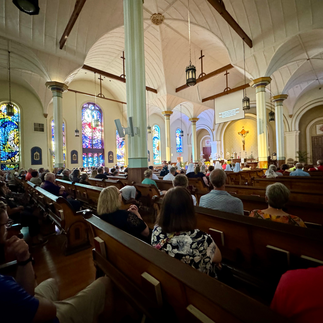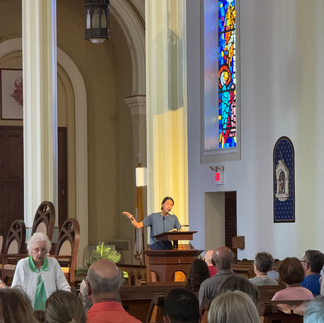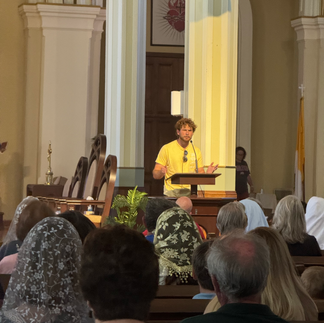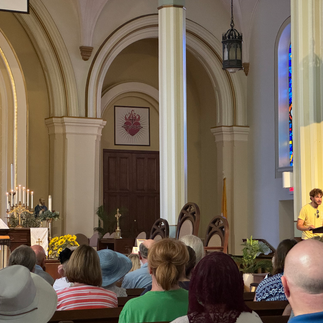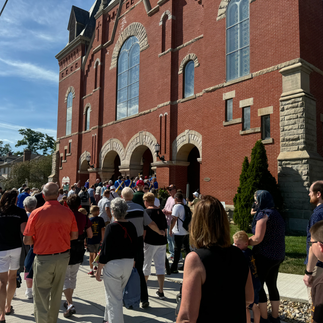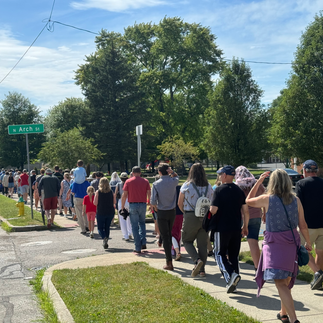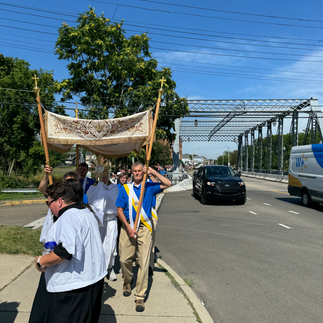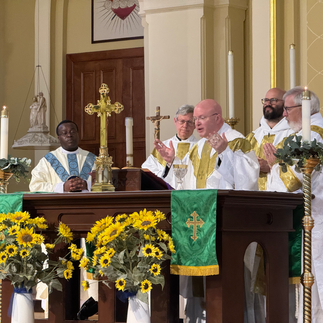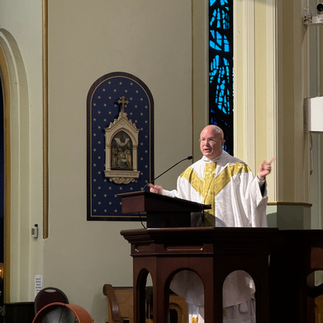Day 39 — Drawing More People to the Narrow Way Following Christ the Way in the Eucharist
- SetonPilgrimage24
- Jun 25, 2024
- 4 min read
Updated: Jul 3, 2024
NEWARK, OHIO, June 25 — The Seton Route Pilgrims of the National Eucharistic Pilgrimage had a prayerful 39th day along their 65-day journey with a Mass, procession, holy hour and benediction in Newark, Ohio.
The day began with Mass at the Church of St. Francis de Sales celebrated by Seton chaplain Father Justin Alarcón, CFR, concelebrated by seven priests, and attended by hundreds of faithful. Father Roger Landry, permanent Seton Route chaplain.
In his homily, Father Landry, after introducing the purpose of the National Eucharistic Revival and National Eucharistic Pilgrimage, and introducing the route's patroness, St. Elizabeth Ann Seton as a Eucharistic convert and saint, he then used Jesus' words in the Gospel to describe three aspects of a truly Eucharistic life.
The first was to treasure Jesus in the Eucharist and not treat him with irreverence, ingratitude or as worthless. Jesus said in the Gospel, "Do not give what is holy to dogs or throw your pearls before swine." In the Didache, written in 80 AD, this passage was used to speak about worthiness to receive holy communion. We need, Father Landry stated, that are consistent with receiving Holy Communion, lives that are in sacramental, doctrinal and moral communion with Jesus. We live in an age, he said, in which some people think everyone should receive Holy Communion, no matter the state of their life; the reason is because some think Jesus is a thing, perhaps even like a piece of birthday cake at a birthday party where everyone feels entitled to a slice; others because they care more for the opinion of others than they do about Jesus. We need to care for him more than we care for infants we love, he stated.
The second response is to live by Eucharistic charity. Jesus gives us the so-called Golden Rule, "Do to others whatever you would have them do to you. This is the law and the prophets." The Eucharist shows us, in fact, the "platinum rule," Landry said, seeking to love others as Christ has loved us first. Receiving Holy Communion is meant to transform us so that we make our lives a commentary on the words of consecration and give our body and blood, sweat, tears, callouses, possessions and time out of love for others.
The third response is to try to help bring others to live Eucharistic lives. Jesus says, “Enter through the narrow gate; for the gate is wide and the road broad that leads to destruction, and those who enter through it are many. How narrow the gate and constricted the road that leads to life. And those who find it are few." Jesus gives a snapshot of how people were trending, and more were distancing themselves from him than following him, rejecting him rather receiving him. The same is true today if you look at how many keep the commandments, the beatitudes, the corporal and spiritual works of mercy, or Jesus' teachings about turning the other cheek, loving our neighbors, forgiving 70 times 7 times, or denying ourselves, picking up our Cross daily and following him. Even five of six Catholics in the United States don't even choose Jesus on the Lord's day. The vast majority of people are trending away from Jesus.
But Jesus doesn't want to leave people on the "highway to hell," Landry continued. His incarnation, his passion, death and resurrection, and his Eucharistic presence are all meant to help rescue them from the broad way that leads to destruction and bring them to the narrow way that leads to life. But we need to be his instruments to help people change the direction of their life: rather than sliding downward, we have to help them lean to follow Christ up the way of the Cross, which is the way of Eucharistic love.
St. Francis de Sales was someone who did, the Columbia Catholic chaplain said. He spent five years risking his life to bring back those who had converted to Calvinism and who were denying Jesus' real presence in the Eucharist. He treasured Christ and the sacraments and wanted to stop their blasphemies; he was filled with a zeal to help them return to the narrow sacramental road; he did to them what in fact Christ had done to him. And he was successful, almost single-handedly, by God's grace, bringing back the whole region. He's praying for us to have that same zeal for the third phase, the missionary phase, of the Eucharistic Revival, Landry concluded.
Later that afternoon, the Seton Route pilgrims transported the Blessed Sacrament in the Pilgrimage support van to the Church of the Blessed Sacrament, where after a period of adoration, there was a Eucharistic procession back to St. Francis de Sales Parish, participated in by hundreds.
After the arrival, there were 90 minutes of Eucharistic adoration during which Seton Pilgrims Dominic Carstens and Natalie Garza gave testimonies as to their own ongoing Eucharistic transformations due to adoration and the Pilgrimage's processions. There was praise and worship music before Father Landry gave Eucharistic benediction.
There was a nice reception hosted by the parish afterward.
























